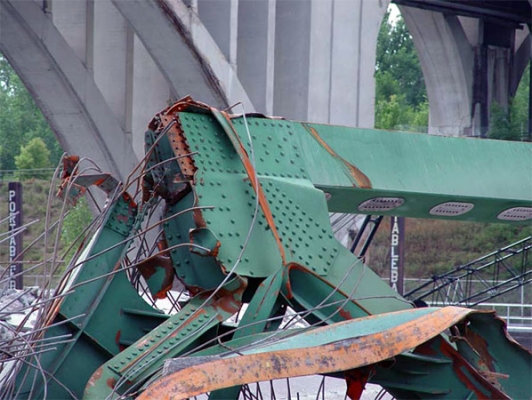Evaluating the safety of fracture-critical bridge connections

An OTREC research project recently took a look at gusset plate connections, the riveted plates of sheet metal that hold steel truss bridges together.
These connective plates have come to the attention of the Federal Highway Administration (FHWA), because in 2007 the collapse of the Interstate-35W Bridge in Minneapolis was the result of a failed gusset plate.
After the collapse, which killed 13 people and injured 145, the FHWA issued a set of guidelines for load rating — or determining the weight-bearing capacity — of gusset plates.
Historically, only bridge truss members were considered for load rating during safety inspections. Gusset plates were thought to be reliable based on conservative assumptions employed during their design.
For more details, visit the project page.
Roughly 20,000 steel bridges in the United States are classified as non-load-path-redundant, or fracture critical, bridges. This means that the failure of a single truss member or connection could lead to collapse.
The problem, says the project's lead investigator Christopher Higgins, happens when a plate goes out of plane. It’s supposed to be perfectly flat, but with too much load put on it, it can develop a bifurcation and go from stable to unstable.
“It’s like stepping on an aluminum can,” Higgins said. “If you have a perfect aluminum can, you can step on it and it can carry a lot of load, but if there is an imperfection -- like if you’ve pressed on it with your thumb -- it will buckle at a very low load.”
The various methods for evaluating gusset plate buckling capacity all have room for improvement. They’re generally based around a set of rule-of-thumb guidelines developed in the 1950s, and more refined techniques are desirable for conducting high-fidelity capacity evaluations on existing bridge connections.
Inclusion of gusset plate connections in load ratings poses a significant challenge to bridge owners. One bridge can have hundreds of gusset plate connections, each in a different position with different forces acting on it. It would take specialized methods to evaluate the capacity of each individual connection.
Higgins and co-investigators Peter Dusicka and Michael Scott set out to develop some of these methods, and to assess the effectiveness of the current guidelines using finite element analysis.
In this research, the experimental work was conducted at Oregon State University under the direction of Christopher Higgins, and the finite element analysis studies were conducted at Portland State University under the direction of Peter Dusika.
The research team conducted six large-scale experiments with a laboratory setup intended, by reinforcing the other bridge elements, to make sure failure occurred in the gusset plates.
They tested the contribution of factors like out-of-plane imperfection and plate thickness to predict the plate’s buckling capacity, then compared their experimental results to existing load-rating techniques and the FHWA Guide to determine their effectiveness.
Their experimental setup was inspired by connection U10 from the I-35W Bridge in Minnesota, shown in the image. This is the connection reported to have failed and which prompted the professional community’s interest in gusset plate performance and this research program.
